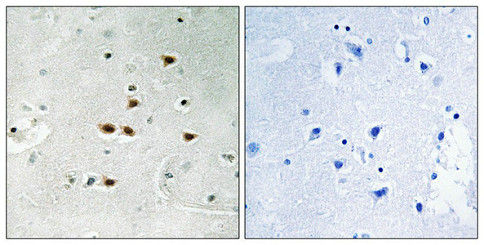
Immunohistochemical analysis of paraffin-embedded human brain tissue using ITCH (Phospho-Tyr420) antibody (left)or the same antibody preincubated with blocking peptide (right).
Phospho-ITCH (Tyr420) Antibody
CSB-PA180347
ApplicationsELISA, ImmunoHistoChemistry
Product group Antibodies
ReactivityHuman, Mouse
TargetITCH
Overview
- SupplierCusabio
- Product NamePhospho-ITCH (Tyr420) Antibody
- Delivery Days Customer20
- ApplicationsELISA, ImmunoHistoChemistry
- CertificationResearch Use Only
- ClonalityPolyclonal
- ConjugateUnconjugated
- Gene ID83737
- Target nameITCH
- Target descriptionitchy E3 ubiquitin protein ligase
- Target synonymsADMFD; AIF4; AIP4; atrophin-1 interacting protein 4; E3 ubiquitin-protein ligase Itchy homolog; HECT-type E3 ubiquitin transferase Itchy homolog; itchy E3 ubiquitin protein ligase homolog; NAPP1; NFE2-associated polypeptide 1
- HostRabbit
- IsotypeIgG
- Protein IDQ96J02
- Protein NameE3 ubiquitin-protein ligase Itchy homolog
- Scientific DescriptionAtrophin-1 contains a polyglutamine repeat, expansion of which is responsible for dentatorubral and pallidoluysian atrophy. The protein encoded by this gene interacts with atrophin-1. This encoded protein is a closely related member of the NEDD4-like protein family. This family of proteins are E3 ubiquitin-ligase molecules and regulate key trafficking decisions, including targeting of proteins to proteosomes or lysosomes. This encoded protein contains four tandem WW domains and a HECT (homologous to the E6-associated protein carboxyl terminus) domain. Chen X., Genomics 73:238-241(2001). Deloukas P., Nature 414:865-871(2001). Wood J.D., Mol. Cell. Neurosci. 11:149-160(1998).
- ReactivityHuman, Mouse
- Storage Instruction-20°C or -80°C
- UNSPSC12352203
